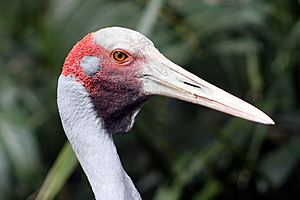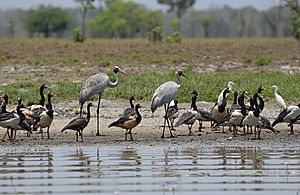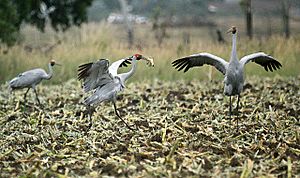Brolga facts for kids
Quick facts for kids Brolga |
|
|---|---|
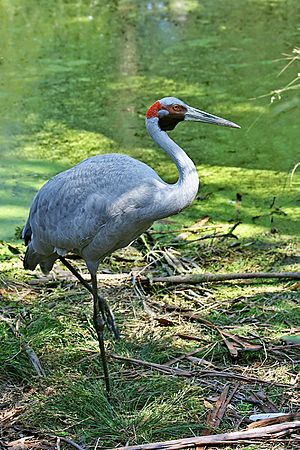 |
|
| Brolga (Antigone rubicunda) |
|
| Conservation status | |
| Scientific classification | |
| Genus: |
Antigone
|
| Species: |
rubicunda
|
| Synonyms | |
|
|
The brolga (Antigone rubicunda) is a large bird from the crane family. People used to call it the "native companion." In 1865, a famous bird expert named John Gould gave it the name "Australian crane."
Brolgas are common birds that like to live in groups. They are found in wetlands across tropical and south-eastern Australia and New Guinea. This tall bird has a small head, a long beak, a thin neck, and long legs. Its feathers are mostly grey, with black tips on its wings. It also has a bright orange-red band of color on its head.
The brolga's special dancing moves are well-known in Australia. These dances are part of how they find a mate. Brolgas build their nests from plants found in wetlands. They usually build them on a raised piece of land or floating on shallow water. They typically lay two eggs. The eggs hatch after 32 days, and the baby birds can move around very soon after they are born. Brolgas eat both plants and small animals.
Even though brolgas are not considered endangered in most places, their numbers are slowly going down. This is especially true in southern Australia. People are working on plans to help protect them in some areas. The brolga has been on the Queensland coat of arms since 1977. It became the official bird for the state in 1986.
Contents
About the Brolga: Its Scientific Name
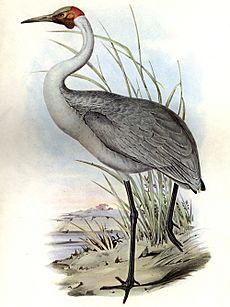
When the brolga was first described in 1810 by a scientist named George Perry, he mistakenly thought it was a type of heron or egret. However, the brolga is actually a crane. Cranes belong to a group of birds called Gruiformes. This group also includes crakes and rails.
Later, bird expert John Gould called it Grus australasianus. He noticed that it was common in northern and eastern Australia. He also wrote that brolgas were easy to tame. He even mentioned that a man named James Macarthur kept two brolgas at his home. Gould called it the "Australian crane" and said its old name was "native companion."
In 1926, the Royal Australasian Ornithologists Union officially named the bird "brolga." This name comes from "burralga," a word in the Gamilaraay language. Scientists have also studied the brolga's DNA. They found that it is closely related to the white-naped crane.
The brolga used to be in the Grus group of cranes. But in 2010, scientists found that this group needed to be changed. So, the brolga and three other species were moved to a different group called Antigone. This group was first named by a German scientist, Ludwig Reichenbach, in 1853.
Scientists once thought there might be two types of brolgas. However, studies of their DNA showed that they are all one type.
What Does a Brolga Look Like?
The brolga is a tall bird with a long, thin neck and long, stilt-like legs. It has a large, slender beak. Male and female brolgas look very similar, but females are usually a bit smaller.
Adult brolgas have a grey-green, featherless area on top of their heads. Their face, cheeks, and throat pouch are also bare and are a coral-red color. Other parts of their head are olive green with dark, stiff feathers. The throat pouch, which hangs down more on adult males, looks black because of these dense feathers.
Their beak is greyish-green, and their eyes are yellowish-orange. The feathers on their body are silvery-grey. The tips of their main wing feathers are black, while the rest of the wing feathers are grey. Their legs and feet are greyish-black.
Young brolgas do not have the red band on their head. Their heads are fully covered in feathers, and their eyes are dark.
A full-grown brolga can be about 2.3 to 4.6 feet (0.7 to 1.4 meters) tall. Its wings can spread out from 5.6 to 7.9 feet (1.7 to 2.4 meters) wide. Adult males usually weigh about 15 pounds (6.8 kg), and females weigh about 12.5 pounds (5.66 kg). Their weight can range from 8 to 19 pounds (3.6 to 8.7 kg). Some very tall brolgas have been reported, reaching up to 5.9 feet (1.8 meters).
It's easy to confuse a brolga with a sarus crane. However, the sarus crane's red head color goes down its neck, while the brolga's red is only on its head. Brolgas are also more silvery-grey. Their legs are blackish, not pink like the sarus crane's. Also, the brolga's calls are lower in pitch. In Australia, sarus cranes are only found in the north-east, while brolgas are found in more places.
Where Brolgas Live and Their Homes
Brolgas are found in many places and are often numerous in northern and north-eastern Australia. They are especially common in north-east Queensland. You can also find them as far south as Victoria. They live in southern New Guinea and sometimes visit New Zealand and northern Western Australia.
In northern Australia, there are an estimated 20,000 to 100,000 brolgas. In southern Australia, there are about 1,000 birds. We don't know how many live in New Guinea. Until 1961, people thought the brolga was the only crane in Australia. Then, the sarus crane was also found in Queensland.
We don't fully understand how brolgas move around Australia. However, large groups are seen in eastern Queensland during non-breeding times. Some brolgas near the coast might travel up to 310 miles (500 km) inland. We know very little about the movements of brolgas in New Guinea.
In Victoria and New South Wales, rain falls more evenly throughout the year. The driest time is from December to May. During this time, southern brolgas gather in large groups in inland areas. These areas include marshes, edges of lakes, and farmlands. When the rain comes in June and July, they spread out to coastal freshwater marshes and shallow lakes to breed.
Queensland has the most brolgas. Sometimes, you can see flocks of over 1,000 birds there. The brolga is Queensland's official bird and is on its coat of arms. Breeding pairs and flocks are found across several floodplains along the Gulf of Carpentaria. Brolgas prefer to live in grassy areas. The largest groups of brolgas are also found in these grassland habitats.
Brolga Habits and Daily Life
Brolgas live in social groups similar to sarus cranes. When it's time to breed, pairs of brolgas protect their nesting areas from other brolgas. If they have chicks, they stay in these areas with their young. Younger birds and adults without breeding territories also live in these areas.
When it's not breeding season, brolgas gather in large flocks. These flocks seem to be made up of many smaller family groups rather than one big group. Within these flocks, families sometimes stay together and do things as a unit.
When brolgas take off from the ground, their flight can look a bit clumsy. They flap their wings a lot. You can see their black wingtips when they are flying. Once they gain speed, their flight becomes much smoother. They often fly very high, circling in the sky. Sometimes, they let out a loud, rough cry.
What Brolgas Eat
Brolgas eat many different things. They look for food in wetlands, salty marshes, and farmlands. They use their strong beaks to dig into the ground to find bulbs and roots.
Brolgas in northern Australia eat a wide variety of foods, not just plants. They also eat the shoots and leaves of plants, grains, insects, mollusks, crustaceans, frogs, and lizards. In salty marshes, they can drink salty water. They have special glands near their eyes that help them get rid of extra salt. Studies of their feathers show that their diet is very varied.
Brolga Reproduction and Life Cycle

Brolgas usually stay with the same mate for their whole lives. However, if one bird dies, the other might find a new partner. A special sign of a bonded pair is their calling together. The female usually starts. She stands with her wings folded and her beak pointing up. She makes a series of loud, trumpeting calls. The male stands next to her in a similar pose, but his wings are spread out. This is the only time you can easily tell the male and female apart. The male makes one long call for every two calls from the female.
Brolgas are famous for their amazing mating dances. The dance starts with a bird picking up some grass. It tosses the grass into the air and then catches it with its beak. Then, the bird jumps about 3 feet (1 meter) into the air with its wings spread wide. It continues by stretching its neck, bowing, walking proudly, calling out, and bobbing its head up and down. Sometimes, only one brolga dances for its mate. Often, they dance in pairs. Sometimes, a whole group of about a dozen brolgas dance together. They line up facing each other before they begin.
Brolgas breed across Australia and New Guinea. The breeding season mostly depends on when it rains, not the time of year. In areas with monsoons, it's from February to May after the rainy season. In southern Australia, it's from September to December.
Both male and female brolgas build the nest. It's a raised mound made of uprooted grass and other plants. They build it on a small island in shallow water, or sometimes floating. Sometimes, they build very little nest at all, or they might use an old swan nest. They might even just lay eggs on the bare ground.
Brolgas usually have one group of chicks per year. They typically lay two eggs, but sometimes one or three. The eggs are dull white with reddish-brown spots. They are about 3.7 inches (95 mm) long and 2.4 inches (61 mm) wide. Both parents take turns sitting on the eggs. The female usually sits at night. The eggs hatch after about 32 days. The chicks are covered in grey fuzz and weigh about 3.5 ounces (100 g) when they hatch. They can leave the nest within a day or two.
Both parents feed and protect the young. The chicks grow their feathers within 4 to 5 weeks. They are fully feathered within 3 months and can fly about 2 weeks after that. If a predator comes near, the chicks hide and stay quiet. The parents might pretend to have a broken wing to distract the predator. Adults continue to protect their young for up to 11 months, or even longer if they don't breed again soon.
Brolga pairs keep their own areas for raising chicks. These areas can be quite large, with a mix of farmland and wetlands. Families sleep in wetlands at night and travel to and from these spots. Each family uses several wetlands within their area.
Protecting the Brolga
The IUCN Red List of Threatened Species says the brolga is of "least concern". This means it has a large range and more than 10,000 birds. Even though the population might be slowly decreasing, it's not going down fast enough to be in a more serious category. Brolgas are not listed as threatened under Australia's main environmental law. However, their protection status can be different in each Australian state. For example, in Victoria, the brolga is listed as "vulnerable" (meaning it's at risk).
The main dangers to brolgas, especially in southern Australia, include:
- Habitat loss: Their homes are being destroyed, especially by the spread of certain trees and the draining of wetlands.
- Power lines: They can crash into power lines.
- Fires and grazing: Changes in how land is managed can harm them.
- Invasive species: New plants or animals can cause problems.
- Egg collecting: People sometimes take their eggs.
Brolgas are safer in north-eastern Australia because many floodplains there are not good for farming. However, new building projects in these areas could still affect their populations. Wind farms are also a new danger. Studies show it's important to build wind turbines away from wetlands where brolgas sleep at night.
To help protect brolgas, people are doing many things:
- Working with other countries.
- Giving them legal protection.
- Doing research and monitoring their numbers.
- Managing their habitats.
- Educating people about them.
- Keeping brolgas in zoos to help them breed and be released back into the wild.
While brolgas breed well in the wild, it has been much harder to get them to breed in captivity.
See also
 In Spanish: Grulla brolga para niños
In Spanish: Grulla brolga para niños



